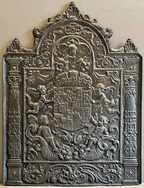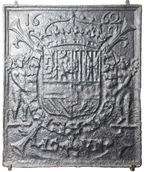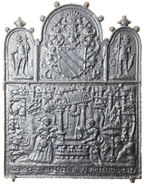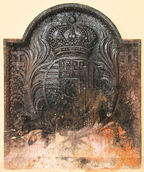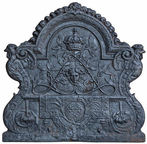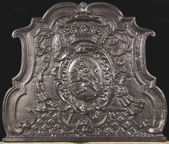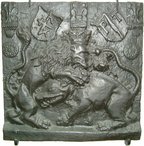-
1203
Description: Arched rectangular central panel with bead on fillet edging; central shield of the Dutch house of Orange impaling English royal Stuart, surmounted by a crown and supported by two putti; above, a maske with two descending grape bunches; below, two more putti seated on scrolls and cornucopiae; a drapery swag and bow in each top corner; arched rectangular border with cavetto-moulded edging and canted top corners; on each side, a Corinthian column and entablature on a pedestal, the columns with floriate decoration; below, a symmetrical swirled design; above the arch, from a scallop shell on each shoulder, two serpents rising towards a third scallop on top.
Notes: The arms are of William IV Prince of Orange (1650-1702) impaling those of his wife, Mary, Queen of Great Britain. Note, these are not the royal arms of William III and Mary II as joint sovereigns, but as Prince and Princess of Orange. William and Mary married in 1677 and Mary died in 1694, so the fireback dates from between 1689, when Mary became Queen, and 1694. A fireback of the same design with the arms of Louis XIV of France is illustrated by Elling and Winkler-Borck, p.213; it has the initials AD in the cartouche above the arch, not visible on this casting.
Arms: William of Orange
Manufactured: in the late-17th century possibly in the Siegerland area of Germany.
Current location: Lassco, Three Pigeons, Milton Common, , Great Milton, Oxfordshire, England.
Citation: Elling, W. & Winkler-Borck, S., 1992, Ofen- und Kaminplatten (Vreden, Hamaland-Museum).
-
524
Description: Rectangular; cavetto-moulded edging; shield, crown and supporters of King Philip IV of Spain, incorporating the arms of Castille and Leon, Aragon - Sicily, Granada, Portugal, Austria, Burgundy and Brabant; around the shield is the chain of the Order of the Golden Fleece; at the top, the date split by the crown; behind, crossed lilies.
Notes: By 1662 the arms of Portugal were redundant on the Spanish royal arms, but were retained until after the death of Philip IV; the word, LOVEN, indicates the particular association of this plate with the town of Leuven, the capital of Brabant in what was, at the time, part of the Spanish Netherlands. Mitford collection, Petworth House.
Inscription: 16 62 / LO VEN
Arms: King Philip IV of Spain
- Decoration tags:
- rectangular (shape)
- double fillet (edging)
- whole carved pattern
- individual numbers
- armorial
- royal
- text
Manufactured: in 1662 possibly in the Eifel area of Germany.
Current location: Petworth House, Petworth, West Sussex, England.
Museum number: NT/PET/M/78 (part of the National Trust museum group)
- Attached to series:
- Foreign armorial firebacks
-
529
Description: Rectangular with three arches, the middle one larger than the outer two; cavetto-moulded edging; bottom panel, pictorial scene of Jesus and the woman of Samaria at the well (John 4), with other figures, buildings etc. in the background, illegible text below; centre arch, shield, helm, crest and mantling of unidentified arms, the initials 'GP' in bottom corners; left arch, probable figure of a saint; right arch, probable figure of a soldier. Mitford collection, Petworth House.
Notes: The combination of a biblical scene (John 4) with a coat of arms.
Inscription: 16 30 / G P
- Decoration tags:
- rectangular with three arches (shape)
- cavetto (edging)
- whole carved pattern
- pictorial
- biblical
- armorial
- text
- humans
Manufactured: in 1630 possibly in the Eifel area of Germany.
Current location: Petworth House, Petworth, West Sussex, England.
Museum number: NT/PET/M/83 (part of the National Trust museum group)
- Attached to series:
- New Testament firebacks
- Foreign armorial firebacks
-
542
Description: Arched rectangular central panel with canted top corners and bead-on-fillet edging; elaborate central cartouche containing the double-headed eagle of the Holy Roman Emperor supported by male and female figures standing on a compartment with fillet edging, containing scrolled foliage and a central fleur-d-lys; above the central cartouche, the imperial crown and swagged drapery; arched rectangular border with canted top corners and cavetto-moulded edging; symmetrical arrangement of traceried foliage; on top, central oval casket with a serpent descending on each side of the arch to a further similar casket on each shoulder of the plate.
Notes: A variation of the standard 'Dutch' style of fireback. Mitford collection, Petworth House.
Manufactured: in the mid- to late-17th century possibly in the Siegerland area of Germany.
Current location: Petworth House, Petworth, West Sussex, England.
Museum number: NT/PET/M/97 (part of the National Trust museum group)
- Attached to series:
- 'Dutch' Miscellaneous Firebacks
- Foreign armorial firebacks
-
820
Description: Arched rectangular shape; wide fillet and egg-and-dart ovolo edging; central oval armorial with fillet edging, palm fronds on each side, tied below, a crown above; in each top corner, the cross of Lorraine.
Notes: The arms are those of Duke Leopold I of Lorraine, who also bore the titles of King of Jerusalem, Hungary and Aragon, and Duke of Anjou, Bar, Gueldre and Juliers.
Arms: Leopold I, Duke of Lorraine and Bar (1680-1729)
- Decoration tags:
- rectangular with round arch (shape)
- ovolo, egg and dart (edging)
- whole carved pattern
- armorial
Manufactured: in the early-18th century possibly in the Lorraine area of France.
Current location: not known.
- Attached to series:
- Foreign armorial firebacks
-
965
Description: Upon a moulded base plinth, wide scrolled side double fillets with foliage about the scrolls and suspended bell flowers in chain above; central foliate cartouche behind an oval shield surmounted by a viscomte's coronet; on top, an arch rising from horizontal moulding on each side.
Notes: Blazon: Azure, a chevron Argent between three estoiles Or, all surmounted by a bar of the second; characteristic of designs illustrated by architects such as Daniel Marot; the texturing on the shield indicates the azure tincture. See Carpentier p. 234, fig. 644.
Arms: Besset de la Chapelle
- Decoration tags:
- rectangular with round arch (shape)
- complex individual (edging)
- whole carved pattern
- armorial
Manufactured: in the late-17th to early-18th century in France.
Current location: not known.
Citation: Carpentier, H., 1912, Plaques de Cheminées (Paris, published by the author).
- Attached to series:
- Foreign armorial firebacks
-
990
Description: Complex quasi-arched rectangular shape with fillet edging; bell flowers descending from the top of the arch; double fillet scrolls at the side with cockerel terminals; under the arch, a royal crown surmounting a counter-posed double 'L' monogram enclosing a human mask with a sunburst; below, a table draped with a cloth bearing a circular royal shield of France within palm leaves.
Notes: A very elaborate and symbolic design alluding to the Sun King, Louis XIV.
- Decoration tags:
- rectangular with round arch (shape)
- fillet (edging)
- whole carved pattern
- architectural
- monogram
- humans
- plants
Manufactured: in the late-17th to early-18th century in France.
Current location: not known.
- Attached to series:
- Foreign armorial firebacks
-
989
Description: Arched rectangular shape with fillet edging; within an arched rectangular border alternating repeated acanthus leaves, and a floral cartouche, a heart-shaped shield of the royal arms of France, surmounted by a royal crown and within splayed olive branches.
Arms: France Royal
- Decoration tags:
- rectangular with round arch (shape)
- fillet (edging)
- whole carved pattern
Manufactured: in the late-17th century in France.
Current location: not known.
- Attached to series:
- Foreign armorial firebacks
-
988
Description: Complex quasi-arched rectangular shape with astragal and fillet edging; within a parallel border and a rococo cartouche an oval shield (argent, a lion rampant sable, crowned, armed and langued gules), surmounted by a ducal coronet, and a bishop's mitre and crozier; above, a bishop's hat with trailing tassels; below, a compartment semie with diamond shapes.
Notes: Henri-Louis-René de Nos (1717-93) was abbot of Saint-Sauveur de Redon in 1747 and later, successively, Bishop of Rennes and of Verdun.
Arms: Henri-Louis-René de Nos
- Decoration tags:
- rectangular with canted top corners and round arch (shape)
- astragal & fillet (edging)
- whole carved pattern
- armorial
Manufactured: in the mid- to late-18th century in France.
Current location: not known.
Citation: Palasi, P., 2014, Plaques de Cheminées Héraldiques (Paris, Éditions Gourcuff-Gradenigo).
- Attached to series:
- Foreign armorial firebacks
-
739
Description: Rectangular; a crowned lion fighting a boar in high relief on a raised bottom panel; above, a stamp formed from a fleur-de-lys on a bracket repeated three times, centre left and right corners; two angled shields and two sunburst discs.
Notes: The shields probably signify civic or personal allegiance; the symbolism of the fighting beasts is not known. Part of the bequest to the Victoria and Albert Museum by Lieut. Colonel G. B. Croft-Lyons in 1926.
Inscription: P T
- Decoration tags:
- rectangular (shape)
- none (edging)
- whole carved pattern
- heraldic
- armorial
- text
- animals
Manufactured: in the late-16th to early-17th century in Germany.
Current location: Victoria & Albert Museum, Cromwell Road, Kensington & Chelsea, Greater London, England.
Museum number: M.576-1926 (part of the Victoria & Albert Museum museum group)
- Attached to series:
- Foreign armorial firebacks
